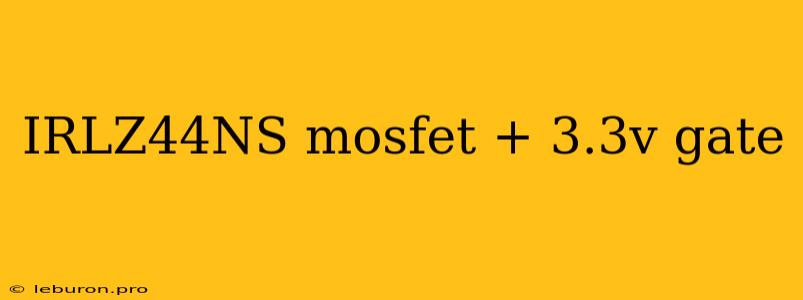The IRLZ44NS is a popular N-channel MOSFET often used in various electronic applications. Its versatility stems from its high current handling capability and low on-resistance, making it suitable for switching high currents efficiently. One common application involves controlling high-power loads with a low voltage logic signal, particularly in situations where the gate drive voltage is limited to 3.3V. This article will delve into the intricacies of using the IRLZ44NS MOSFET with a 3.3V gate drive, exploring its key characteristics and considerations for optimal performance.
Understanding the IRLZ44NS MOSFET
The IRLZ44NS is an N-channel MOSFET, meaning it conducts current when a positive voltage is applied to its gate terminal. This voltage creates an electric field that attracts electrons from the source to the drain, establishing a conductive path. The MOSFET's on-resistance, denoted as R<sub>DS(on)</sub>, represents the resistance between the drain and source terminals when the device is fully turned on. A low R<sub>DS(on)</sub> value signifies minimal power dissipation and efficient current flow.
Key Parameters:
- Voltage ratings: The IRLZ44NS has a drain-source voltage (V<sub>DS</sub>) rating of 60V, indicating it can handle up to 60 volts between its drain and source terminals.
- Current handling: The device is capable of handling a continuous drain current (I<sub>D</sub>) of 50A, signifying its ability to switch high currents.
- Gate threshold voltage: The gate-source voltage (V<sub>GS(th)</sub>) required to turn the MOSFET on is typically around 2.5V. However, this value can vary slightly between individual devices.
Driving the IRLZ44NS with a 3.3V Gate
Driving a MOSFET with a 3.3V gate requires understanding the device's characteristics and employing appropriate techniques. The IRLZ44NS's gate threshold voltage of 2.5V implies that a 3.3V gate drive can reliably turn it on.
Considerations for 3.3V Gate Drive:
- Gate drive strength: The 3.3V signal must be capable of delivering sufficient current to charge the MOSFET's gate capacitance quickly. Insufficient current can result in slow switching times, impacting the device's performance.
- Gate voltage level: While a 3.3V gate drive is sufficient to turn on the IRLZ44NS, it might not fully saturate the MOSFET. This can lead to a higher than desired R<sub>DS(on)</sub>, potentially affecting power dissipation and efficiency.
- Gate drive circuit: Implementing a suitable gate drive circuit is crucial. It should provide a low output impedance to minimize voltage drops across the gate resistor during switching.
Gate Drive Circuit Examples:
- Direct drive: The simplest approach involves directly connecting the 3.3V signal to the MOSFET's gate, with a series resistor to limit the gate current. However, this approach can lead to slow switching times, especially if the gate capacitance is significant.
- Gate driver IC: Utilizing a dedicated gate driver IC offers improved switching speeds and more controlled gate drive waveforms. These ICs typically provide a low output impedance and can handle high currents, ensuring faster transitions between on and off states.
- Logic level MOSFET: Consider using a logic level MOSFET designed specifically for 3.3V gate drive applications. These devices have a lower gate threshold voltage, typically around 1.8V, ensuring complete saturation with a 3.3V signal.
Applications with 3.3V Gate Drive:
- Motor control: The IRLZ44NS is frequently used in motor control applications, switching high currents required by electric motors. With a 3.3V gate drive, it can be controlled by a microcontroller or other logic circuits.
- Power supplies: The MOSFET can serve as a switching element in power supplies, switching power on and off efficiently with a 3.3V logic control signal.
- Lighting control: The IRLZ44NS can control the brightness of LEDs and other lighting elements by adjusting the current flow with a 3.3V gate drive.
Conclusion
Driving the IRLZ44NS MOSFET with a 3.3V gate offers a practical and efficient way to control high-power loads using low-voltage logic signals. By understanding the device's characteristics and implementing appropriate gate drive techniques, one can ensure optimal performance and reliable switching. Whether using a direct drive approach, a dedicated gate driver IC, or a logic level MOSFET, careful consideration of gate drive strength, voltage level, and circuit design is paramount for successful operation. The applications of the IRLZ44NS with a 3.3V gate are vast, ranging from motor control and power supplies to lighting systems and other demanding electronic circuits.
